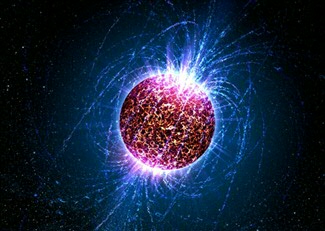High-Energy Astrophysics and Active Galaxies

At the end of the life of a very massive star (>~ 8 solar masses), gravity can force the protons and electrons in the star's core to combine into neutrons, forming a neutron star (~1-2 solar masses, radius of 10-15 km). The rest of the star is blown away in this process, also called a Type II supernova. Further collapse is prevented by the repulsion between the neutrons due to the Pauli exclusion principle (also known as the pressure of a degenerate neutron gas).
Neutron stars
Neutron stars have strong magnetic fields and are fast rotators. Pulsars are also believed to be neutron stars that rotate so fast that they emit a beam of radiation along their magnetic axis, which is not necessarily aligned with their axis of rotation. Like a lighthouse, this beam, when pointing towards Earth, can be picked up as a pulsar.
Black holes
For even more massive stars, the core can be so massive that no known mechanism can prevent further collapse into a singularity: a black hole is formed. These objects have the strongest gravitational fields in the universe. Even light cannot escape if it is too close to the singularity. However, quantum mechanical effects do cause black holes to emit so-called Hawking radiation and eventually evaporate, long after the last stars in the universe have died. Their strong gravity attracts gas from nearby stars, which forms a disk when accreted, and heats up so much that it can emit X-rays.
We can learn more about the dynamics in the vicinity of the black hole by studying the emission in the X-ray bands. There are also strong reasons to believe that the centres of galaxies often host supermassive black holes, and some even show their activity as AGNs and quasars. Both neutron stars and black holes also show imprints of the curvature of spacetime as predicted by General Relativity, which has strong implications for astrophysics and cosmology in general.

Key questions
Research at the Kapteyn Institute focuses on the physics of accretion on neutron stars and low-mass black holes, the effects of extremely strong gravitational fields and the internal composition of neutron stars.
In particular, it investigates the following questions: What are the properties of matter under the extreme conditions prevailing in the interior of a neutron star? And what are the observed characteristics of black holes? What are the physical and geometric properties of the accretion flow in these systems, and how is accretion related to the relativistic jets observed on radio waves? How do nearby particles and radiation behave, and can we observationally verify the extraordinary predictions of general relativity for the properties of curved spacetime near these objects?
Kapteyn staff are working on the symbiosis between active galactic nuclei (AGNs) and starbursts in powerful AGNs, unification of AGNs and the occurrence of ultra-faint AGNs in deep fields. In addition, the composition and kinematics of stars and the ISM in AGN host galaxies and the properties of AGN-driven radio sources, including remnants, are studied both by themselves and in their IGM interaction.
Projects
Some projects and programmes in which the institute is involved include multi-wavelength studies of AGN with LOFAR, Herschel, Spitzer, and studies of neutron stars and black holes with XMM-Newton and NICER.
Future research
Future directions of high-energy astrophysics and AGN research at the Kapteyn Institute focus on the proposed X-ray telescope ATHENA together with SRON, and the use of LOFAR/SKA in AGN studies. Furthermore, the use of ALMA, SPICA/SAFARI in AGN studies and the use of APERTIF (ARTS) in studying pulsars, rotating radio transits and fast radio bursts.
Scientific staff
Scientific staff working in this field: Barthel, Mendez, Morganti, Wang
Cosmic rays
Cosmic rays are subatomic particles accelerated in explosive cosmic events or objects driven by strong gravity. More than a century after their discovery, the sources of cosmic rays have yet to be unambiguously identified because they do not travel in straight trajectories. However, when cosmic rays collide with matter and radiation, they produce very high-energy gamma rays (VHE) that point directly back to their distant birthplaces.
These gamma rays hold the key to some of the most profound questions about our Universe and provide an overview of the objects where the extremes of matter prevail, such as black holes, neutron stars or their fusion events that produce gravitational waves. VHE gamma rays also promise to reveal the true nature of dark matter.
Research on cosmic rays
Research at the Kapteyn Institute focuses on the high-energy universe as seen in cosmic and gamma rays, from both experimental and phenomenological perspectives. Kapteyn staff are involved in the detection of cosmic rays with the Alpha Magnetic Spectrometer in space and in the detection of gamma rays with the High Energy Stereoscopic System (HESS) experiment and the upcoming Cherenkov Telescope Array (CTA).
Scientific staff on cosmic rays
Scientific staff working in this field: Manuela Vecchi.
| Last modified: | 09 October 2024 10.10 a.m. |
